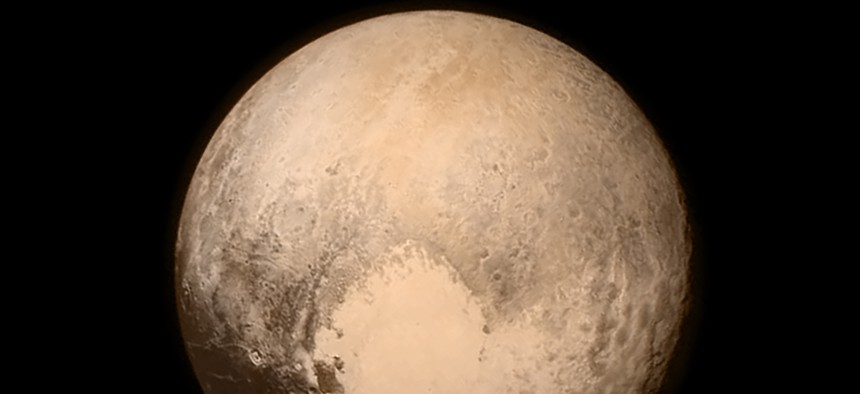
Not a planet, but still amazing. NASA
Here Are The Most Interesting Things We Learned About Pluto This Week From NASA
It took 53 years, but human beings have now seen all nine planets in our solar system up close and personal.
In 2006, several months after New Horizons launched into space, Pluto stopped being a planet.
That was according to the world's top astronomers, who said the celestial body failed to meet one of the requirements of being classified as a planet: having enough mass to clear its orbit of other bodies with similar size. But that didn't matter to New Horizons, the spacecraft NASA had dispatched to study the planet at the edge of the solar system. Since then, the probe—about the size of a baby grand piano —has traveled more than 3 billion miles to give human beings their first close-up look at the mysterious dwarf planet.
Before New Horizons, we could only see Pluto as a speck in the vast darkness of outer space. But early Tuesday morning, the spacecraft flew within 7,750 miles of Pluto, swiftly capturing images as it passed. And just before 9 p.m., New Horizons signaled back to NASA scientists on Earth, confirming a successful flyby.
The mission marks the end of an enormous era in planetary exploration for the United States that began more than 50 years ago , when NASA's Mariner 2 made it to Venus on Dec. 14, 1962, becoming the first space probe to successfully encounter another planet. The country has now visited every planet in the solar system.
The images sent back to Earth so far are mesmerizing . And there's more to come as New Horizons transmits vast amounts of data—on Pluto's composition, its atmosphere, and its moons—which will take months. Here are a few of the most interesting things that the NASA mission uncovered this week:
Pluto has a massive icy mountain range and a polar ice cap
Images sent back to Earth indicate that Pluto has a complex and varied terrain. The spacecraft's measurements have confirmed that the dwarf planet has a polar ice cap, and photos released on Wednesday show that Pluto has a mountain range that NASA scientists estimate stands at roughly 11,000 feet high. That's comparable in size to the Rocky Mountains.
NASA estimates that the mountain range may be less than 100 million years old based on the absence of craters nearby. If that's true, the range would be much younger than the solar system and that could mean that Pluto may still be geologically active. NASA scientists believe that the mountains formed from water ice.

Images from New Horizons indicate that Pluto's largest moon, Charon, also has a diverse terrain that appears to include troughs, cliffs, canyons, and craters. NASA scientists believe that Charon may have also been recently geologically active.
"Charon just blew our socks off," Cathy Olkin, a New Horizons deputy project scientist, said during a press conference Wednesday.

Pluto is bigger than we thought
New Horizons returned measurements for the diameter of the dwarf planet that clocked in at roughly 1,473 miles—larger than what scientists previously estimated. That data puts to rest a decades-long debate over Pluto's true size, and, according to NASA, makes Pluto "larger than all other known solar-system objects beyond the orbit of Neptune."

That still doesn't qualify Pluto as a full-blown planet.
The size data also suggests that the dwarf planet's atmosphere may be thinner than previously believed. A larger diameter translates to lower overall density , which likely means that Pluto is made up of more ice and less rock than previously imagined.
Hydra, Pluto's most distant moon, is likely made up mostly of water ice
Like Rita's Water Ice! Just kidding. New Horizons has sent back the best images ever taken of Hydra, Pluto's furthest-away moon, that indicate a high degree of reflectivity. NASA scientists say that the reflectivity of the surface likely means that the surface of Hydra is largely made up mostly of water ice .
Before New Horizons collected data on Hydra, scientists "were completely uncertain" as to the size of the moon, said Hal Weaver, a New Horizons project scientist, during a news conference Wednesday. Previously, scientists predicted that Hydra could be anywhere from 20 to 100 miles wide. Data from New Horizons has revealed that the moon is 28 miles long and 19 miles in diameter.

Hydra's distance from New Horizons means that the most recently transmitted image is still blurry, but it nonetheless provides a vast amount of previously unknown data.
NEXT STORY: It’s Time to Make Good on Phased Retirement






